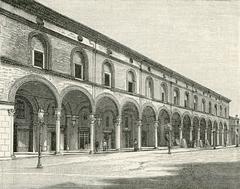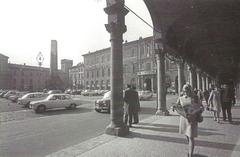
Imola Cathedral: Visiting Hours, Tickets, and Historical Sites Guide
Date: 04/07/2025
Introduction
Imola Cathedral—formally the Cathedral of San Cassiano Martire—anchors the historic center of Imola, Italy, and serves as a powerful testament to over 1,600 years of religious, architectural, and cultural evolution. With roots in early Christianity, the cathedral is dedicated to Saint Cassian, Imola’s patron saint and martyr, and stands today as both an active center of worship and a remarkable artistic monument in Emilia-Romagna.
This guide provides an in-depth exploration of Imola Cathedral’s layered history, highlights its distinctive architectural and artistic features, and offers all the essential practical information you need to plan your visit—including up-to-date visiting hours, ticket details, accessibility, guided tour options, and travel tips. Whether you’re a pilgrim, an art lover, or a cultural traveler, Imola Cathedral offers a rich, multifaceted experience in the heart of northern Italy.
For the latest visitor updates, virtual tours, and detailed event listings, consult the Imola tourism portal.
Table of Contents
- Origins and Early History
- Architectural Evolution: Romanesque to Neoclassical
- Artistic Heritage and Notable Features
- Spiritual and Historical Significance
- Visiting Imola Cathedral: Practical Information
- Frequently Asked Questions (FAQ)
- Summary and Visitor Recommendations
- Sources and Further Reading
Origins and Early History
Imola Cathedral’s origins stretch back to the 4th or 5th century CE, when the first basilica was erected to honor Saint Cassian, martyred during Emperor Diocletian’s persecutions around 304 CE. Over centuries, the cathedral’s footprint grew alongside Imola’s development, evolving from its early Christian basilica form into a formidable Romanesque church by the 10th and 11th centuries. The crypt, one of the oldest surviving parts, preserves mosaics and relics from these early periods (Imola tourism portal).
Architectural Evolution: Romanesque to Neoclassical
The cathedral underwent major transformations across the Middle Ages and Renaissance. The Romanesque structure featured thick walls and rounded arches, a hallmark of early medieval ecclesiastical architecture. Renaissance renovations, notably under Bishop Giovanni Maria Ciocchi del Monte (later Pope Julius III), introduced classical columns and vibrant frescoes.
The most significant rebuilding occurred in the late 18th century, when architect Cosimo Morelli redesigned the cathedral in Neoclassical style. Completed in 1781, the new structure featured a Latin cross floor plan, a majestic dome, and a symmetrical brick and stucco façade characterized by pilasters, cornices, and a central pediment. The 52-meter bell tower, a later addition, remains a dominant feature of Imola’s skyline (Italy Review).
Artistic Heritage and Notable Features
Interior Layout and Decorative Highlights
Inside, visitors encounter a spacious nave flanked by aisles with Corinthian columns, leading to a luminous dome supported by pendentives and drum windows. Frescoes by Alessandro Della Nave and Antonio Villa enliven the ceilings and dome with biblical scenes and depictions of Saint Cassian’s life. The flooring, inlaid with polychrome marble, draws attention to the high altar—a masterwork of 18th-century marble sculpture adorned with statues.
Side chapels display altarpieces by regional artists, including Innocenzo da Imola and Giuseppe Maria Crespi, while the marble pulpit and 16th-century baptismal font showcase the skill of local artisans. Stained glass windows, though modern, cast colorful light throughout the nave, and the finely carved wooden choir stalls in the apse exemplify late 18th-century craftsmanship.
Crypt and Relics
Beneath the sanctuary lies the atmospheric crypt, accessible to visitors and housing the silver reliquary of Saint Cassian. Medieval columns and low vaulted ceilings create an intimate, contemplative space, contrasting with the grandeur of the main church. The crypt is a focal point of veneration, especially during the annual feast of Saint Cassian (catholicshrinebasilica.com).
Pipe Organ and Musical Heritage
The cathedral’s grand organ, installed in 1797 and crafted by Gaetano Callido, is celebrated for its rich acoustic quality. With over 2,000 pipes, it is regularly featured in liturgical services and concerts, especially during religious festivals (Italy Review).
Spiritual and Historical Significance
Imola Cathedral has long served as the spiritual heart of the city, the seat of the local diocese, and a center for major religious celebrations. Notable bishops include Pope Pius IX (Giovanni Maria Mastai-Ferretti), who oversaw the cathedral’s reconstruction, and Pope Alexander VII and Pope Pius VII, both former bishops of Imola who later ascended to the papacy (christianedirectory.com). The cathedral was elevated to minor basilica status by Pope John Paul II in 1981, underscoring its ecclesiastical importance.
Visiting Imola Cathedral: Practical Information
Location and Accessibility
- Address: Piazza del Duomo, 40026 Imola BO, Italy
- Getting There: Easily accessible by train (frequent service from Bologna), local buses, taxi, or on foot from Imola’s train station. The nearest airport is Bologna Guglielmo Marconi Airport (things.in).
Visiting Hours
- Monday to Saturday: 9:00 AM – 12:30 PM; 3:30 PM – 6:00 PM
- Sundays & Public Holidays: 8:00 AM – 12:30 PM; 3:30 PM – 7:00 PM
- Note: Hours may vary during special events and religious ceremonies. Check the Imola tourism portal or local listings before visiting.
Tickets and Entry
- Admission: Free for all visitors. Donations are welcome and support ongoing preservation efforts.
- Group Visits & Tours: For educational groups or special tours, advance reservation is recommended (+39054222146).
Dress Code and Visitor Etiquette
- Modest attire is required (shoulders and knees covered). Shawls or scarves are usually available at the entrance (things.in).
- Please maintain a respectful silence, especially during services.
Guided Tours and Audio Guides
- Guided Tours: Available by prior arrangement or during peak seasons. Tours cover the history, art, and religious significance of the cathedral (overyourplace.com).
- Audio Guides: The Audiala app offers detailed self-guided tours.
Accessibility for Visitors with Disabilities
- The cathedral offers ramps and level entrances for wheelchair users. Some areas of the crypt or side chapels may be less accessible due to steps or uneven floors (christianedirectory.com). Staff assistance is available upon request.
Photography Policy
- Photography is generally permitted without flash or tripods. Be discreet and avoid photographing during services.
Best Times to Visit
- Early mornings and late afternoons are quieter and ideal for reflection or photography.
- The feast of Saint Cassian (August 13) features special liturgies and processions.
Nearby Attractions
- Rocca Sforzesca Fortress: A medieval fortification a short walk from the cathedral.
- San Domenico Museum: Noted for art and archaeology.
- Imola Historic Center: Cafés, shops, and local markets surround the Piazza del Duomo (placesandthingstodo.com).
Special Events and Festivals
- The cathedral hosts concerts, art exhibitions, and major religious festivals throughout the year. The annual feast of Saint Cassian is a highlight for locals and visitors alike (overyourplace.com).
Frequently Asked Questions (FAQ)
Q: Are there any entrance fees to visit Imola Cathedral?
A: No, entry is free. Donations are appreciated.
Q: What are the cathedral’s visiting hours?
A: Monday–Saturday, 9:00 AM–12:30 PM and 3:30 PM–6:00 PM; Sundays/holidays, 8:00 AM–12:30 PM and 3:30 PM–7:00 PM. Check local sources for updates.
Q: Is the cathedral accessible for those with mobility challenges?
A: Most main areas are accessible; some parts of the crypt may have limited access.
Q: Are guided tours available?
A: Yes, by prior arrangement or during high season. Contact the cathedral (+39054222146) for details.
Q: Can I take photos inside?
A: Yes, but please avoid using flash and tripods, and be respectful during services.
Q: What is the best time to visit?
A: Spring (April–June) and autumn (September–October) offer pleasant weather and fewer crowds.
Summary and Visitor Recommendations
Imola Cathedral is a living monument to faith, history, and Italian artistry. Its free admission, accessible features, and wealth of art and architecture make it an essential stop in Emilia-Romagna. Enhance your visit with a guided tour or the Audiala app audio guide, attend a musical event, and explore Imola’s other attractions nearby. For up-to-date information, consult official resources and plan ahead—particularly if you wish to participate in special events or religious celebrations.
Sources and Further Reading
- Imola Cathedral Visiting Hours, Tickets, and Historical Guide to Imola’s Iconic Monument
- Imola Cathedral Visiting Guide: Architecture, History, and Practical Tips for Emilia-Romagna Travelers
- Cathedral of San Cassiano, Imola listing
- Imola travel guide
- Local Insights on Imola Attractions
- Imola Sightseeing Guide
- Imola Cathedral on Pineqone
- Cathedral of San Cassiano Basilica Overview



